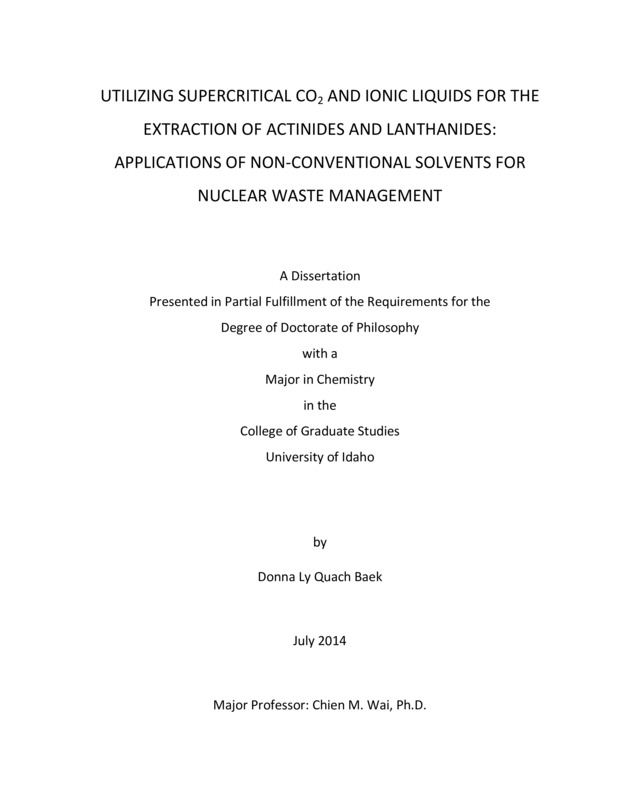UTILIZING SUPERCRITICAL CO2 AND IONIC LIQUIDS FOR THE EXTRACTION OF ACTINIDES AND LANTHANIDES: APPLICATIONS OF NON-CONVENTIONAL SOLVENTS FOR NUCLEAR WASTE MANAGEMENT
Baek, Donna. (2014). UTILIZING SUPERCRITICAL CO2 AND IONIC LIQUIDS FOR THE EXTRACTION OF ACTINIDES AND LANTHANIDES: APPLICATIONS OF NON-CONVENTIONAL SOLVENTS FOR NUCLEAR WASTE MANAGEMENT. Theses and Dissertations Collection, University of Idaho Library Digital Collections. https://www.lib.uidaho.edu/digital/etd/items/baek_idaho_0089e_10040.html
- Title:
- UTILIZING SUPERCRITICAL CO2 AND IONIC LIQUIDS FOR THE EXTRACTION OF ACTINIDES AND LANTHANIDES: APPLICATIONS OF NON-CONVENTIONAL SOLVENTS FOR NUCLEAR WASTE MANAGEMENT
- Author:
- Baek, Donna
- Date:
- 2014
- Program:
- Chemistry
- Subject Category:
- Chemistry; Nuclear chemistry
- Abstract:
-
Supercritical carbon dioxide (sc-CO2) and room temperature ionic liquids (RTILs) were used as non-conventional solvents for the investigation of actinide and lanthanide extraction and separation in this dissertation. Nuclear waste management is traditionally facilitated by the Plutonium Uranium Reduction EXtraction process, better known as the PUREX process. The drawback to this important process is the production of hazardous organic and aqueous waste. RTILs and sc-CO2 have inherent benefits over using hydrocarbon solvents, such as low volatility and minimizing secondary liquid waste generation.
A brief review of actinide and lanthanide extraction and separation using traditional solvents, sc-CO2, and RTILs is presented. To be able to optimize extraction efficiencies, the understanding of solvation, speciation, and complexation behavior of lanthanides and actinides in RTILs, sc-CO2 and RTIL/sc-CO2 mixtures is important. Thus, the coordination of U(VI) with nitrate and TBP dissolved in 1-butyl-3-methylimidazolium bis(trifluoromethylsulfonyl)imide ([C4MIM][Tf2N]) containing tetrabutylammonium nitrate (TBAN), nitric acid, or TBAN and TBP via ATR-FTIR and UV-Vis spectroscopy was studied.
Tristructual isotropic (TRISO) fuel particles are used in very high temperature reactors to achieve higher burnup levels; however, recycling techniques have not been fully developed. Included in this dissertation is an investigation using sc-CO2 with TBP to extract U(VI) from TRISO fuel particles, which have been exposed to gamma irradiation. Also, mechanical crushing of TRISO fuel particles is currently the only method to expose the uranium for extraction; thus radioactive contamination is an issue. Ultrasound was applied to TRISO fuel particles in an enclosed pressure vessel in the attempt to fracture the fuel in liquid CO2 and extract U(VI).
Furthermore, various actinides and lanthanides are present in used nuclear fuel that need to be extracted and separated from each other to recover uranium as the product and reduce the radiotoxicity of the waste requiring storage. The extraction and separation of uranium from the actinides neptunium, plutonium and americium and the lanthanide series were studied. These species were extracted from a range of nitric acid concentrations, in the absence of, or in the presence of, a number of traditional reducing and/or complexing agents by sc-CO2 modified with TBP to demonstrate the separation of these metals from uranium under sc-CO2 conditions.
- Description:
- doctoral, Ph.D., Chemistry -- University of Idaho - College of Graduate Studies, 2014
- Major Professor:
- Wai, Chien M
- Committee:
- Mincher, Bruce J; Pasilis, Sofie P; Paviet, Patricia D
- Defense Date:
- 2014
- Identifier:
- Baek_idaho_0089E_10040
- Type:
- Text
- Format Original:
- Format:
- application/pdf
- Rights:
- In Copyright - Educational Use Permitted. For more information, please contact University of Idaho Library Special Collections and Archives Department at libspec@uidaho.edu.
- Standardized Rights:
- http://rightsstatements.org/vocab/InC-EDU/1.0/

